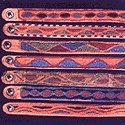
Games, Toys, Dolls, Kites, Sports, Paper Crafts, Papier Mache, Writing Accessories
Paper Kites of Nepal
The making and flying of kites is an ancient tradition followed in Nepal. Though kite flying – like elsewhere in the East – is a popular pastime in Nepal, the locally crafted kites made of Daphne bark (lokta) paper are facing stiff competition from the imported variety.
Though kites are flown throughout the year, they are linked with some ritual and auspicious occasions during the festival of Indra Jatra. This festival is structured around agricultural cycles, with God Indra being venerated as the harbinger of the rains. The kites act as the farmer’s emissaries and are flown during the jatra as an for of appeal to Lord Indra to bring forth the rains for a bountiful harvest. The kites, it is believed, reach Lord Indra, who then heeds the message(s).
Kite-flying competitions start in the autumn in Nepal – the gentle breeze of this season is perfect for kite-flying. Many participate in this sport and there is a brisk sale of kites at this time.
PROCESS & TECHNIQUE
Nepali kites are simple and elegant in design; they are usually constructed in a square format with paper and bamboo strips. The kite consists of semi-circular and straight bamboo strips that are pasted on to white (or coloured) lokta bark paper with home-made rice glue. The straight bamboo strips are fixed in the diagonal position and meet the semi-circular strip at the centre. This cross spar provides stability to the kite and it allows the wind to bow the kite back and create a curved shape. These flat kites are constructed in a manner that when the wind puts pressure on the face of the kite the bow flexes back in a curve. This makes the kite stable and allows it to fly well in the direction in which it is pointing. In flat kites the tail also adds stability by keeping the kite pointing into the wind by adding drag or resistance to the rear. Kites with tails can often fly in very strong winds.
Tiny holes are pierced through the paper in the kite, along the diagonally fixed strip and thread lines are inserted and tied. Both the ends of the thread are joined to the long thread line, which is wound around a wooden dumb-bell shaped device (lattain). The lattain is made in different sizes; in the large size several meters of thread can be wound around it. The lattain is held along its handles, which protrude on either side and are held firmly by both the hands – the kite flying is controlled either by releasing the thread or by winding it up.
Nepali kites are very light and fragile and therefore need to be handled very carefully not only in damp or cold conditions but also when using or storing them.
Gallery
YOUR VIEWS
PRACTITIONERS: INDIA
Access 70,000+ practitioners in 2500+ crafts across India.
BIBLIOGRAPHY
10,000+ listings on arts, crafts, design, heritage, culture etc.
GLOSSARY
Rich and often unfamiliar vocabulary of crafts and textiles.
SHOP at India InCH
Needs to be written.





